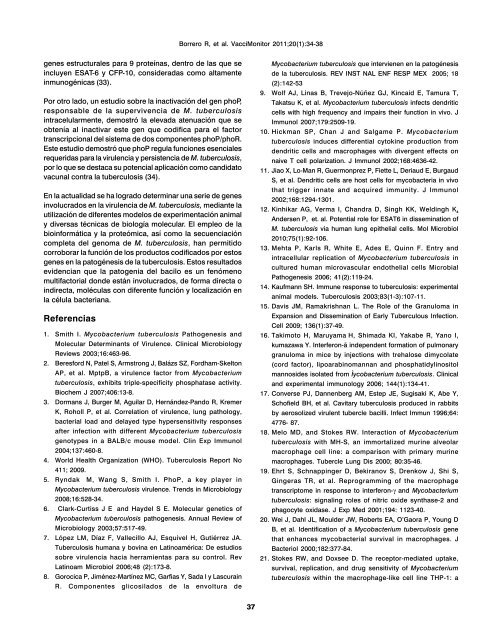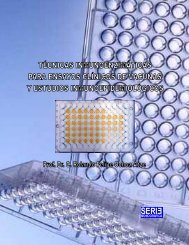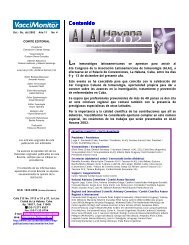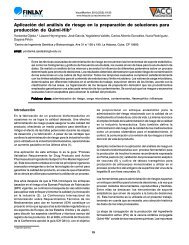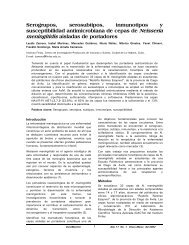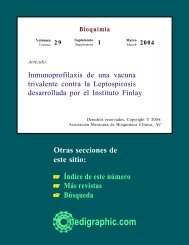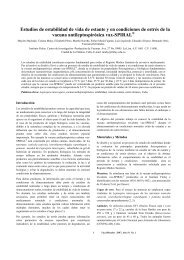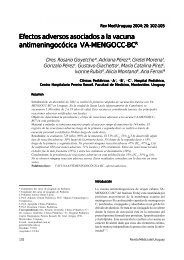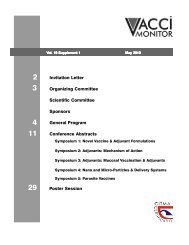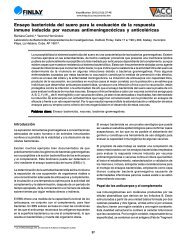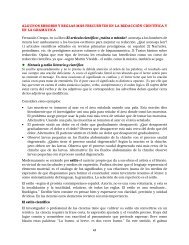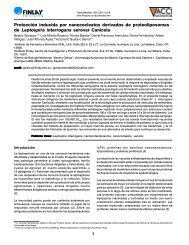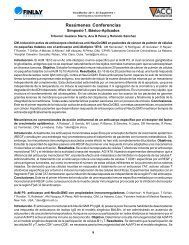Mycobacterium tuberculosis: factores de virulencia - Instituto Finlay
Mycobacterium tuberculosis: factores de virulencia - Instituto Finlay
Mycobacterium tuberculosis: factores de virulencia - Instituto Finlay
You also want an ePaper? Increase the reach of your titles
YUMPU automatically turns print PDFs into web optimized ePapers that Google loves.
genes estructurales para 9 proteínas, <strong>de</strong>ntro <strong>de</strong> las que se<br />
incluyen ESAT-6 y CFP-10, consi<strong>de</strong>radas como altamente<br />
inmunogénicas (33).<br />
Por otro lado, un estudio sobre la inactivación <strong>de</strong>l gen phoP,<br />
responsable <strong>de</strong> la supervivencia <strong>de</strong> M. <strong>tuberculosis</strong><br />
intracelularmente, <strong>de</strong>mostró la elevada atenuación que se<br />
obtenía al inactivar este gen que codifica para el factor<br />
transcripcional <strong>de</strong>l sistema <strong>de</strong> dos componentes phoP/phoR.<br />
Este estudio <strong>de</strong>mostró que phoP regula funciones esenciales<br />
requeridas para la <strong>virulencia</strong> y persistencia <strong>de</strong> M. <strong>tuberculosis</strong>,<br />
por lo que se <strong>de</strong>staca su potencial aplicación como candidato<br />
vacunal contra la <strong>tuberculosis</strong> (34).<br />
En la actualidad se ha logrado <strong>de</strong>terminar una serie <strong>de</strong> genes<br />
involucrados en la <strong>virulencia</strong> <strong>de</strong> M. <strong>tuberculosis</strong>, mediante la<br />
utilización <strong>de</strong> diferentes mo<strong>de</strong>los <strong>de</strong> experimentación animal<br />
y diversas técnicas <strong>de</strong> biología molecular. El empleo <strong>de</strong> la<br />
bioinformática y la proteómica, así como la secuenciación<br />
completa <strong>de</strong>l genoma <strong>de</strong> M. <strong>tuberculosis</strong>, han permitido<br />
corroborar la función <strong>de</strong> los productos codificados por estos<br />
genes en la patogénesis <strong>de</strong> la <strong>tuberculosis</strong>. Estos resultados<br />
evi<strong>de</strong>ncian que la patogenia <strong>de</strong>l bacilo es un fenómeno<br />
multifactorial don<strong>de</strong> están involucrados, <strong>de</strong> forma directa o<br />
indirecta, moléculas con diferente función y localización en<br />
la célula bacteriana.<br />
Referencias<br />
1. Smith I. <strong>Mycobacterium</strong> <strong>tuberculosis</strong> Pathogenesis and<br />
Molecular Determinants of Virulence. Clinical Microbiology<br />
Reviews 2003;16:463-96.<br />
2. Beresford N, Patel S, Armstrong J, Balázs SZ, Fordham-Skelton<br />
AP, et al. MptpB, a virulence factor from <strong>Mycobacterium</strong><br />
<strong>tuberculosis</strong>, exhibits triple-specificity phosphatase activity.<br />
Biochem J 2007;406:13-8.<br />
3. Dormans J, Burger M, Aguilar D, Hernán<strong>de</strong>z-Pando R, Kremer<br />
K, Roholl P, et al. Correlation of virulence, lung pathology,<br />
bacterial load and <strong>de</strong>layed type hypersensitivity responses<br />
after infection with different <strong>Mycobacterium</strong> <strong>tuberculosis</strong><br />
genotypes in a BALB/c mouse mo<strong>de</strong>l. Clin Exp Immunol<br />
2004;137:460-8.<br />
4. World Health Organization (WHO). Tuberculosis Report No<br />
411; 2009.<br />
5. Ryndak M, Wang S, Smith I. PhoP, a key player in<br />
<strong>Mycobacterium</strong> <strong>tuberculosis</strong> virulence. Trends in Microbiology<br />
2008;16:528-34.<br />
6. Clark-Curtiss J E and Hay<strong>de</strong>l S E. Molecular genetics of<br />
<strong>Mycobacterium</strong> <strong>tuberculosis</strong> pathogenesis. Annual Review of<br />
Microbiology 2003;57:517-49.<br />
7. López LM, Díaz F, Vallecillo AJ, Esquivel H, Gutiérrez JA.<br />
Tuberculosis humana y bovina en Latinoamérica: De estudios<br />
sobre <strong>virulencia</strong> hacia herramientas para su control. Rev<br />
Latinoam Microbiol 2006;48 (2):173-8.<br />
8. Gorocica P, Jiménez-Martínez MC, Garfias Y, Sada I y Lascurain<br />
R. Componentes glicosilados <strong>de</strong> la envoltura <strong>de</strong><br />
Borrero R, et al. VacciMonitor 2011;20(1):34-38<br />
37<br />
<strong>Mycobacterium</strong> <strong>tuberculosis</strong> que intervienen en la patogénesis<br />
<strong>de</strong> la <strong>tuberculosis</strong>. REV INST NAL ENF RESP MEX 2005; 18<br />
(2):142-53<br />
9. Wolf AJ, Linas B, Trevejo-Núñez GJ, Kincaid E, Tamura T,<br />
Takatsu K, et al. <strong>Mycobacterium</strong> <strong>tuberculosis</strong> infects <strong>de</strong>ndritic<br />
cells with high frequency and impairs their function in vivo. J<br />
Immunol 2007;179:2509-19.<br />
10. Hickman SP, Chan J and Salgame P. <strong>Mycobacterium</strong><br />
<strong>tuberculosis</strong> induces differential cytokine production from<br />
<strong>de</strong>ndritic cells and macrophages with divergent effects on<br />
naive T cell polarization. J Immunol 2002;168:4636-42.<br />
11. Jiao X, Lo-Man R, Guermonprez P, Fiette L, Deriaud E, Burgaud<br />
S, et al. Dendritic cells are host cells for mycobacteria in vivo<br />
that trigger innate and acquired immunity. J Immunol<br />
2002;168:1294-1301.<br />
12. Kinhikar AG, Verma I, Chandra D, Singh KK, Weldingh K,<br />
An<strong>de</strong>rsen P, et. al. Potential role for ESAT6 in dissemination of<br />
M. <strong>tuberculosis</strong> via human lung epithelial cells. Mol Microbiol<br />
2010;75(1):92-106.<br />
13. Mehta P, Karls R, White E, A<strong>de</strong>s E, Quinn F. Entry and<br />
intracellular replication of <strong>Mycobacterium</strong> <strong>tuberculosis</strong> in<br />
cultured human microvascular endothelial cells Microbial<br />
Pathogenesis 2006; 41(2):119-24.<br />
14. Kaufmann SH. Immune response to <strong>tuberculosis</strong>: experimental<br />
animal mo<strong>de</strong>ls. Tuberculosis 2003;83(1-3):107-11.<br />
15. Davis JM, Ramakrishnan L. The Role of the Granuloma in<br />
Expansion and Dissemination of Early Tuberculous Infection.<br />
Cell 2009; 136(1):37-49.<br />
16. Takimoto H, Maruyama H, Shimada KI, Yakabe R, Yano I,<br />
kumazawa Y. Interferon-ã in<strong>de</strong>pen<strong>de</strong>nt formation of pulmonary<br />
granuloma in mice by injections with trehalose dimycolate<br />
(cord factor), lipoarabinomannan and phosphatidylinositol<br />
mannosi<strong>de</strong>s isolated from Ìycobacterium <strong>tuberculosis</strong>. Clinical<br />
and experimental immunology 2006; 144(1):134-41.<br />
17. Converse PJ, Dannenberg AM, Estep JE, Sugisaki K, Abe Y,<br />
Schofield BH, et al. Cavitary <strong>tuberculosis</strong> produced in rabbits<br />
by aerosolized virulent tubercle bacilli. Infect Immun 1996;64:<br />
4776- 87.<br />
18. Melo MD, and Stokes RW. Interaction of <strong>Mycobacterium</strong><br />
<strong>tuberculosis</strong> with MH-S, an immortalized murine alveolar<br />
macrophage cell line: a comparison with primary murine<br />
macrophages. Tubercle Lung Dis 2000; 80:35-46.<br />
19. Ehrt S, Schnappinger D, Bekiranov S, Drenkow J, Shi S,<br />
Gingeras TR, et al. Reprogramming of the macrophage<br />
transcriptome in response to interferon-γ and <strong>Mycobacterium</strong><br />
<strong>tuberculosis</strong>: signaling roles of nitric oxi<strong>de</strong> synthase-2 and<br />
phagocyte oxidase. J Exp Med 2001;194: 1123-40.<br />
20. Wei J, Dahl JL, Moul<strong>de</strong>r JW, Roberts EA, O’Gaora P, Young D<br />
B, et al. I<strong>de</strong>ntification of a <strong>Mycobacterium</strong> <strong>tuberculosis</strong> gene<br />
that enhances mycobacterial survival in macrophages. J<br />
Bacteriol 2000;182:377-84.<br />
21. Stokes RW, and Doxsee D. The receptor-mediated uptake,<br />
survival, replication, and drug sensitivity of <strong>Mycobacterium</strong><br />
<strong>tuberculosis</strong> within the macrophage-like cell line THP-1: a


